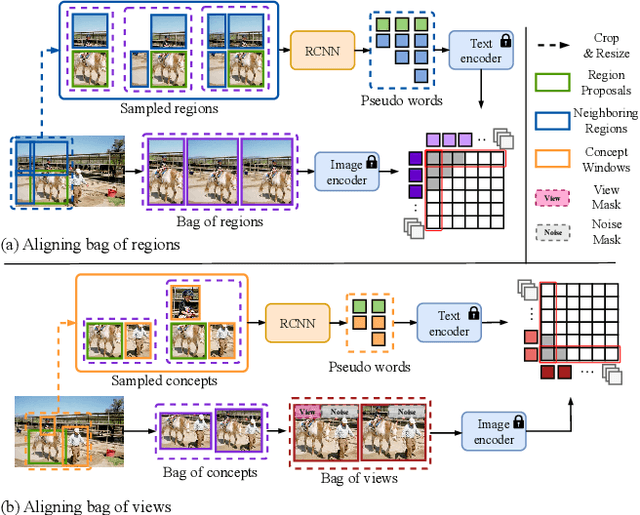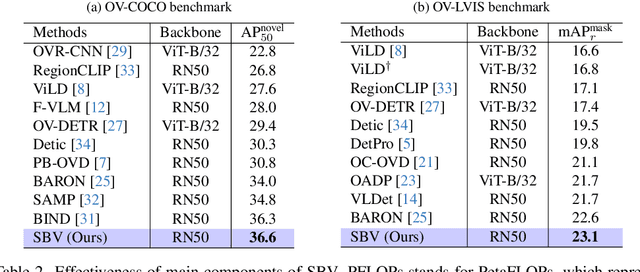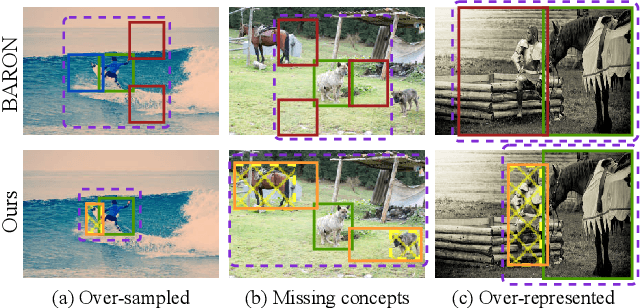Hyunjung Shim
Robust Driving QA through Metadata-Grounded Context and Task-Specific Prompts
Oct 21, 2025Abstract:We present a two-phase vision-language QA system for autonomous driving that answers high-level perception, prediction, and planning questions. In Phase-1, a large multimodal LLM (Qwen2.5-VL-32B) is conditioned on six-camera inputs, a short temporal window of history, and a chain-of-thought prompt with few-shot exemplars. A self-consistency ensemble (multiple sampled reasoning chains) further improves answer reliability. In Phase-2, we augment the prompt with nuScenes scene metadata (object annotations, ego-vehicle state, etc.) and category-specific question instructions (separate prompts for perception, prediction, planning tasks). In experiments on a driving QA benchmark, our approach significantly outperforms the baseline Qwen2.5 models. For example, using 5 history frames and 10-shot prompting in Phase-1 yields 65.1% overall accuracy (vs.62.61% with zero-shot); applying self-consistency raises this to 66.85%. Phase-2 achieves 67.37% overall. Notably, the system maintains 96% accuracy under severe visual corruption. These results demonstrate that carefully engineered prompts and contextual grounding can greatly enhance high-level driving QA with pretrained vision-language models.
Multi-Objective Task-Aware Predictor for Image-Text Alignment
Oct 01, 2025Abstract:Evaluating image-text alignment while reflecting human preferences across multiple aspects is a significant issue for the development of reliable vision-language applications. It becomes especially crucial in real-world scenarios where multiple valid descriptions exist depending on contexts or user needs. However, research progress is hindered by the lack of comprehensive benchmarks and existing evaluation predictors lacking at least one of these key properties: (1) Alignment with human judgments, (2) Long-sequence processing, (3) Inference efficiency, and (4) Applicability to multi-objective scoring. To address these challenges, we propose a plug-and-play architecture to build a robust predictor, MULTI-TAP (Multi-Objective Task-Aware Predictor), capable of both multi and single-objective scoring. MULTI-TAP can produce a single overall score, utilizing a reward head built on top of a large vision-language model (LVLMs). We show that MULTI-TAP is robust in terms of application to different LVLM architectures, achieving significantly higher performance than existing metrics and even on par with the GPT-4o-based predictor, G-VEval, with a smaller size (7-8B). By training a lightweight ridge regression layer on the frozen hidden states of a pre-trained LVLM, MULTI-TAP can produce fine-grained scores for multiple human-interpretable objectives. MULTI-TAP performs better than VisionREWARD, a high-performing multi-objective reward model, in both performance and efficiency on multi-objective benchmarks and our newly released text-image-to-text dataset, EYE4ALL. Our new dataset, consisting of chosen/rejected human preferences (EYE4ALLPref) and human-annotated fine-grained scores across seven dimensions (EYE4ALLMulti), can serve as a foundation for developing more accessible AI systems by capturing the underlying preferences of users, including blind and low-vision (BLV) individuals.
PosterForest: Hierarchical Multi-Agent Collaboration for Scientific Poster Generation
Aug 29, 2025Abstract:We present a novel training-free framework, \textit{PosterForest}, for automated scientific poster generation. Unlike prior approaches, which largely neglect the hierarchical structure of scientific documents and the semantic integration of textual and visual elements, our method addresses both challenges directly. We introduce the \textit{Poster Tree}, a hierarchical intermediate representation that jointly encodes document structure and visual-textual relationships at multiple levels. Our framework employs a multi-agent collaboration strategy, where agents specializing in content summarization and layout planning iteratively coordinate and provide mutual feedback. This approach enables the joint optimization of logical consistency, content fidelity, and visual coherence. Extensive experiments on multiple academic domains show that our method outperforms existing baselines in both qualitative and quantitative evaluations. The resulting posters achieve quality closest to expert-designed ground truth and deliver superior information preservation, structural clarity, and user preference.
3D-Aware Vision-Language Models Fine-Tuning with Geometric Distillation
Jun 11, 2025Abstract:Vision-Language Models (VLMs) have shown remarkable performance on diverse visual and linguistic tasks, yet they remain fundamentally limited in their understanding of 3D spatial structures. We propose Geometric Distillation, a lightweight, annotation-free fine-tuning framework that injects human-inspired geometric cues into pretrained VLMs without modifying their architecture. By distilling (1) sparse correspondences, (2) relative depth relations, and (3) dense cost volumes from off-the-shelf 3D foundation models (e.g., MASt3R, VGGT), our method shapes representations to be geometry-aware while remaining compatible with natural image-text inputs. Through extensive evaluations on 3D vision-language reasoning and 3D perception benchmarks, our method consistently outperforms prior approaches, achieving improved 3D spatial reasoning with significantly lower computational cost. Our work demonstrates a scalable and efficient path to bridge 2D-trained VLMs with 3D understanding, opening up wider use in spatially grounded multimodal tasks.
Rethinking Direct Preference Optimization in Diffusion Models
May 24, 2025



Abstract:Aligning text-to-image (T2I) diffusion models with human preferences has emerged as a critical research challenge. While recent advances in this area have extended preference optimization techniques from large language models (LLMs) to the diffusion setting, they often struggle with limited exploration. In this work, we propose a novel and orthogonal approach to enhancing diffusion-based preference optimization. First, we introduce a stable reference model update strategy that relaxes the frozen reference model, encouraging exploration while maintaining a stable optimization anchor through reference model regularization. Second, we present a timestep-aware training strategy that mitigates the reward scale imbalance problem across timesteps. Our method can be integrated into various preference optimization algorithms. Experimental results show that our approach improves the performance of state-of-the-art methods on human preference evaluation benchmarks.
No Thing, Nothing: Highlighting Safety-Critical Classes for Robust LiDAR Semantic Segmentation in Adverse Weather
Mar 20, 2025Abstract:Existing domain generalization methods for LiDAR semantic segmentation under adverse weather struggle to accurately predict "things" categories compared to "stuff" categories. In typical driving scenes, "things" categories can be dynamic and associated with higher collision risks, making them crucial for safe navigation and planning. Recognizing the importance of "things" categories, we identify their performance drop as a serious bottleneck in existing approaches. We observed that adverse weather induces degradation of semantic-level features and both corruption of local features, leading to a misprediction of "things" as "stuff". To mitigate these corruptions, we suggest our method, NTN - segmeNt Things for No-accident. To address semantic-level feature corruption, we bind each point feature to its superclass, preventing the misprediction of things classes into visually dissimilar categories. Additionally, to enhance robustness against local corruption caused by adverse weather, we define each LiDAR beam as a local region and propose a regularization term that aligns the clean data with its corrupted counterpart in feature space. NTN achieves state-of-the-art performance with a +2.6 mIoU gain on the SemanticKITTI-to-SemanticSTF benchmark and +7.9 mIoU on the SemanticPOSS-to-SemanticSTF benchmark. Notably, NTN achieves a +4.8 and +7.9 mIoU improvement on "things" classes, respectively, highlighting its effectiveness.
Fine-Grained Image-Text Correspondence with Cost Aggregation for Open-Vocabulary Part Segmentation
Jan 16, 2025Abstract:Open-Vocabulary Part Segmentation (OVPS) is an emerging field for recognizing fine-grained parts in unseen categories. We identify two primary challenges in OVPS: (1) the difficulty in aligning part-level image-text correspondence, and (2) the lack of structural understanding in segmenting object parts. To address these issues, we propose PartCATSeg, a novel framework that integrates object-aware part-level cost aggregation, compositional loss, and structural guidance from DINO. Our approach employs a disentangled cost aggregation strategy that handles object and part-level costs separately, enhancing the precision of part-level segmentation. We also introduce a compositional loss to better capture part-object relationships, compensating for the limited part annotations. Additionally, structural guidance from DINO features improves boundary delineation and inter-part understanding. Extensive experiments on Pascal-Part-116, ADE20K-Part-234, and PartImageNet datasets demonstrate that our method significantly outperforms state-of-the-art approaches, setting a new baseline for robust generalization to unseen part categories.
DGQ: Distribution-Aware Group Quantization for Text-to-Image Diffusion Models
Jan 08, 2025Abstract:Despite the widespread use of text-to-image diffusion models across various tasks, their computational and memory demands limit practical applications. To mitigate this issue, quantization of diffusion models has been explored. It reduces memory usage and computational costs by compressing weights and activations into lower-bit formats. However, existing methods often struggle to preserve both image quality and text-image alignment, particularly in lower-bit($<$ 8bits) quantization. In this paper, we analyze the challenges associated with quantizing text-to-image diffusion models from a distributional perspective. Our analysis reveals that activation outliers play a crucial role in determining image quality. Additionally, we identify distinctive patterns in cross-attention scores, which significantly affects text-image alignment. To address these challenges, we propose Distribution-aware Group Quantization (DGQ), a method that identifies and adaptively handles pixel-wise and channel-wise outliers to preserve image quality. Furthermore, DGQ applies prompt-specific logarithmic quantization scales to maintain text-image alignment. Our method demonstrates remarkable performance on datasets such as MS-COCO and PartiPrompts. We are the first to successfully achieve low-bit quantization of text-to-image diffusion models without requiring additional fine-tuning of weight quantization parameters.
Length-Aware DETR for Robust Moment Retrieval
Dec 30, 2024Abstract:Video Moment Retrieval (MR) aims to localize moments within a video based on a given natural language query. Given the prevalent use of platforms like YouTube for information retrieval, the demand for MR techniques is significantly growing. Recent DETR-based models have made notable advances in performance but still struggle with accurately localizing short moments. Through data analysis, we identified limited feature diversity in short moments, which motivated the development of MomentMix. MomentMix employs two augmentation strategies: ForegroundMix and BackgroundMix, each enhancing the feature representations of the foreground and background, respectively. Additionally, our analysis of prediction bias revealed that short moments particularly struggle with accurately predicting their center positions of moments. To address this, we propose a Length-Aware Decoder, which conditions length through a novel bipartite matching process. Our extensive studies demonstrate the efficacy of our length-aware approach, especially in localizing short moments, leading to improved overall performance. Our method surpasses state-of-the-art DETR-based methods on benchmark datasets, achieving the highest R1 and mAP on QVHighlights and the highest R1@0.7 on TACoS and Charades-STA (such as a 2.46% gain in R1@0.7 and a 2.57% gain in mAP average for QVHighlights). The code is available at https://github.com/sjpark5800/LA-DETR.
Sampling Bag of Views for Open-Vocabulary Object Detection
Dec 24, 2024



Abstract:Existing open-vocabulary object detection (OVD) develops methods for testing unseen categories by aligning object region embeddings with corresponding VLM features. A recent study leverages the idea that VLMs implicitly learn compositional structures of semantic concepts within the image. Instead of using an individual region embedding, it utilizes a bag of region embeddings as a new representation to incorporate compositional structures into the OVD task. However, this approach often fails to capture the contextual concepts of each region, leading to noisy compositional structures. This results in only marginal performance improvements and reduced efficiency. To address this, we propose a novel concept-based alignment method that samples a more powerful and efficient compositional structure. Our approach groups contextually related ``concepts'' into a bag and adjusts the scale of concepts within the bag for more effective embedding alignment. Combined with Faster R-CNN, our method achieves improvements of 2.6 box AP50 and 0.5 mask AP over prior work on novel categories in the open-vocabulary COCO and LVIS benchmarks. Furthermore, our method reduces CLIP computation in FLOPs by 80.3% compared to previous research, significantly enhancing efficiency. Experimental results demonstrate that the proposed method outperforms previous state-of-the-art models on the OVD datasets.
 Add to Chrome
Add to Chrome Add to Firefox
Add to Firefox Add to Edge
Add to Edge